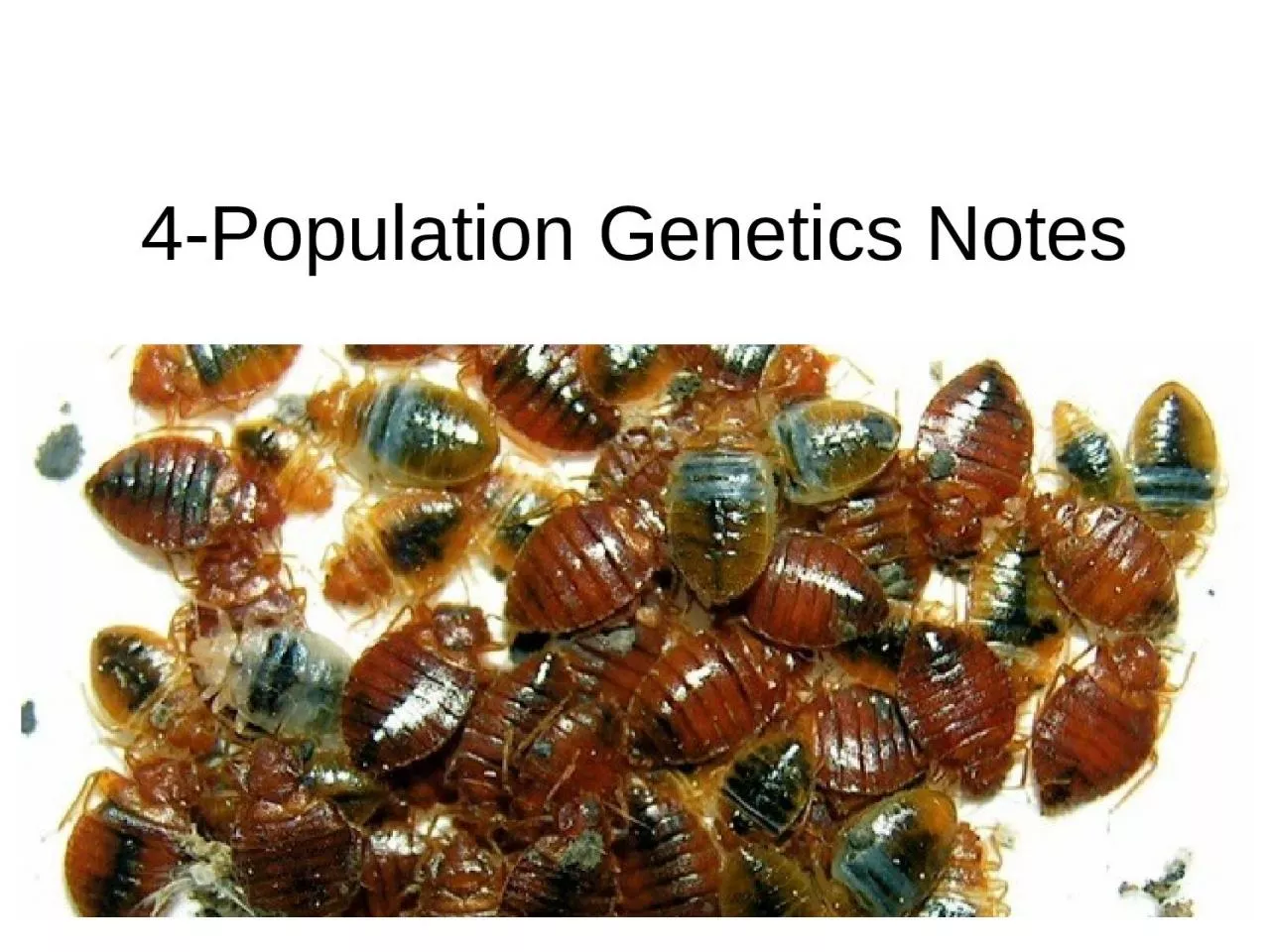

Population genetics focuses on genetic changes within an interbreeding population Gene pool Allele Frequency all the genes in a population Shows frequency of ID: 918802
Download Presentation The PPT/PDF document "4-Population Genetics Notes" is the property of its rightful owner. Permission is granted to download and print the materials on this web site for personal, non-commercial use only, and to display it on your personal computer provided you do not modify the materials and that you retain all copyright notices contained in the materials. By downloading content from our website, you accept the terms of this agreement.
Slide1
4-Population Genetics Notes
Slide2Population genetics
: focuses on genetic changes within an interbreeding population.
Gene pool = _______________________________
Allele Frequency =
all the genes in a population
Shows frequency of each allele in the gene pool (0.625 B, 0.375 b)
Slide3Changing the Gene Pool
Microevolution:
a change in a population’s gene pool over a succession of generations (a brief period of geologic time). Microevolution may be due to natural selection or other factors such as genetic drift.
Genetic Drift: random change of allele frequencies in a small population due to
chance , not natural selection.
Slide4Founder Effect
:
______________________
___________________________Example: ___________________________
migration of a small group to a new area can lead to genetic drift.
Amish in America (extra digits)
Slide5Bottleneck Effect:
________ ___________
Example: _________________
an event that drastically lowers the population numbers
endangered species
Slide6Slide7Genetic Equilibrium: Allele frequencies are not changing =
________________
no evolution
Slide8Slide9The Hardy Weinberg principle describes a hypothetical situation in which there is no change in the gene pool (frequencies of alleles), hence no evolution.
The frequencies
of
alleles will remain unchanged generation after generation (= NO EVOLUTION) if the following conditions are met:
Large populationRandom mating No mutation
No migrationNo natural selection
Slide10The Hardy-Weinberg Equation:
To estimate the frequency of alleles in a population, we can use the Hardy-Weinberg equation.
p
2
+ 2pq + q
2 = 1and p + q = 1Using the equation:
p
= the
dominant
allele
frequency
(represented here by
A
).
q
= the
recessive
allele
frequency
(
represented here by
a
)
For a population in genetic equilibrium:
p
+
q
= 1.0
(The sum of the frequencies of both alleles is
1.)
Slide11(
p
+
q
)2 = 1
so p2 + 2pq + q2 = 1
The three terms of this binomial expansion
indicate the frequencies of the three genotypes:
p
2
=
genotype frequency of
AA
(homozygous
dominant)
2pq
=
genotype frequency of
Aa
(heterozygous
)
q
2
=
genotype frequency of
aa
(homozygous recessive)
The Hardy-Weinberg Equation:
Slide12SAMPLE PROBLEM #1:
In pigs, black coat is recessive to white.
What is the
percentage
of
heterozygotes in this population?
Calculate
q
2
: Count the individuals that are
homozygous recessive in the illustration to the
left. Calculate the
frequency
of the total
population they
represent. This is
q
2
.
q
2
= 4/16 = 0.25
Slide13SAMPLE PROBLEM #1:
In pigs, black coat is recessive to white.
What is the
percentage
of
heterozygotes in this population? 2. Find q
: Take the square root of
q
2
to obtain
q
,
the frequency of the recessive allele.
q
= √0.25 = 0.5
Slide14SAMPLE PROBLEM #1:
In pigs, black coat is recessive to white.
What is the
percentage
of
heterozygotes in this population? 3. Find p
: The sum of the frequencies of both
alleles = 100%,
p
+
q
= 1. You know
q
, so what
is
p
, the frequency of the dominant allele?
p = 1 – q
p = 1 - 0.5 = 0.5
Slide15SAMPLE PROBLEM #1:
In pigs, black coat is recessive to white.
What is the
percentage
of
heterozygotes in this population? 4. Find
2
pq
: The frequency of the
heterozygotes
is represented
by 2
pq
.
Multiply by 100 to
calculate the percent of
the population that is
heterozygous
for white
coat
:
2pq = 2(0.5)(0.5)
2pq =
0.5
0.5 * 100=
50% Heterozygous
Slide16